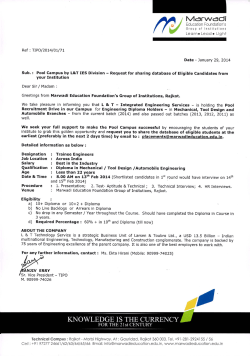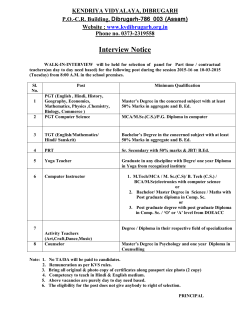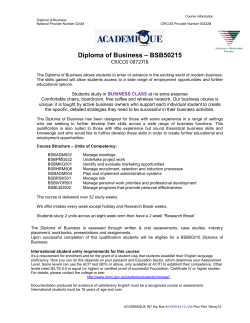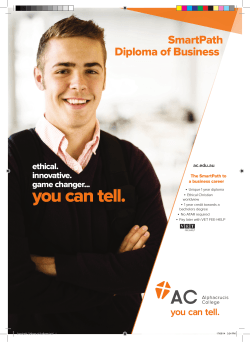
VET FEE-HELP submission A Norton 14-4-15 IC-AN
Senate Education and Employment References Committee Inquiry into the operation, regulation and funding of private vocational education and training (VET) providers in Australia. This submission focuses on the operation of the VET FEE-HELP loan scheme From: Andrew Norton Higher Education Program Director Grattan Institute 1 1. Analysis summary • • • • • 2. The cost of HELP derives from interest subsidies and doubtful debt Vocational education qualification holders are less likely to repay HELP debt than higher education qualification holders because of their lower earnings profiles Overall, we estimate that 40 per cent of VET HELP money lent to people with diploma and advanced diploma qualifications will not be recovered, compared to 21 per cent of HELP lent to people holding bachelor degrees There are gender and field of education differences in VET FEE-HELP doubtful debt The high rate of non-completion in vocational education and among VET FEE-HELP borrowers may exacerbate doubtful debt problems Recommendations summary • • • • The initial threshold at which HELP debt is repaid should be lowered A threshold at the level proposed in the 2014-15 Commonwealth Budget could reduce the level of VET FEE-HELP doubtful debt among people with diploma and advanced diploma qualifications to 30 per cent The threshold should be indexed to the consumer price index rather than average weekly earnings Data held by the Department of Education and Training and the Australian Taxation Office should be provided to researchers to analyse student outcomes 2 3. Introduction This submission focuses on the operation of VET FEE-HELP. As of 2013, about 60 per cent of VET FEE-HELP borrowers were enrolled in private higher education providers. The data used in this report is based on qualification level rather than institution of enrolment. However, the problems we identify with doubtful debt are likely to be present across the public and private vocational education sectors. They reflect economic and social factors affecting the nature of skills acquisition in the vocational sector, labour force participation rates, and wage levels for people with diploma-level qualifications. This submission uses historical income data for diploma qualification holders. This may mean that our income projections are optimistic, given the shift towards higher education qualifications in professional jobs. 4. Background to VET FEE-HELP In 2009 VET FEE-HELP was added to the HELP (formerly HECS) system introduced in 1989 for higher education students. It principally lends money to vocational education diploma and advanced diploma students. It does so on an income contingent basis, with repayments based on income. These loans manage the risk of not being able to make repayments. Only debtors earning more than a threshold have to repay. For repaying debtors, HELP income contingent loans also smooth annual take-home income levels, by requiring lesser repayments by lower income earners. In 2014-15, HELP debtors earning less than $53,345 a year are not required to make loan repayments. Those earning more than this threshold repay at least 4 per cent of their income per annum. Repayment requirements increase gradually with income, peaking at 8 per cent for those earning $99,070 a year or more.1 The Higher Education and Research Reform Bill 2014 would reduce the initial threshold to $50,638 in 2016-17 ($48,198 in current dollars), at which point debtors would repay 2 per cent of their income. As VET FEE-HELP eligibility has expanded to more vocational education providers, in both the public and private sectors, so too has the number of VET FEE-HELP borrowers. In 2013, about 100,000 persons took out a VET FEE-HELP loan.2 The Department of Education and Training estimates that this number could reach 250,000 in the next few years.3 5. Costs of HELP HELP is an expensive program. Aside from administrative expenses, the main costs are interest subsidies and debt not expected to be repaid, commonly known as doubtful debt. Interest subsidies arise because HELP debts are indexed to the consumer price index, which is usually less than the government bond rate. In recent times the bond rate has been low, substantially reducing this cost. Doubtful debt is a result of HELP debtors earning below the threshold or leaving Australia. Eventual HELP repayment rates depend on the repayment rules and how personal circumstances mix with broader social and economic conditions. 1 ATO (2014). Department of Education (2014b). 3 Department of Education (2014f), p. 76 2 3 Trends in costs are shown in Figure 1. In the case of VET FEE-HELP (and undergraduate FEE-HELP), there is a loan fee, which offsets some costs. For most VET FEE-HELP students, the loan fee is 20 per cent of(FY$2014) the face value of the loan.4 The estimated financial Billions of dollars effect of loan fees is also shown in Figure 1. For 2014-15, the net cost of HELP is likely to be around $1.4 billion. HELP costs Figure 1: Annual costs of HELP, 1993-2014 $2 Early payment bonus Up-front discount $1 Addition to doubtful debts Interest costs $0 Loan fees -$1 1993 1996 1999 2002 2005 2008 2011 2014e Notes: Addition to doubtful debt calculations is the increase in doubtful debt since the previous year. Interest cost is calculated as the difference between ten-year Commonwealth bond rate and the indexation rate, multiplied by the level of outstanding debt. Loan fees include both FEE-HELP and VET-FEE-HELP, based on estimates of loan fee-liable lending. Deflated using CPI. Sources: Based on DEEWR (2012), annual reports for portfolios responsible for higher education, information supplied by the Department of Education. The Department of Education has provided projections on doubtful debt costs (Figure 2). These are forecast to escalate significantly, reaching $2.3 billion in 2017-18. 4 The Higher Education and Research Reform Bill 2014 proposed removing this loan fee. However, it is likely that this bill will be defeated and the loan fee will stay. 4 Figure 2: Estimated HELP doubtful debt costs, 2014-15 to 2017-18 $ billion 2.5 2.0 1.5 1.0 0.5 0.0 2014-15 2015-16 2016-17 2017-18 Doubtful debt Source: Department of Education (2014f) 6. VET FEE-HELP and doubtful debt The government does not currently identify the contribution of different HELP schemes to doubtful debt costs. However, it is likely that VET FEE-HELP is contributing disproportionately to HELP doubtful debt. This is because vocational education diploma and advanced diploma students on average will earn less over their careers than higher education students. Figure 3 shows the annual income of diploma and advanced diploma holders compared to bachelor degree holders in 2011.5 It is restricted to the 20-39 year old age group, as the major repayment age group for people who pursue post-secondary education soon after completing school.6 As expected, diploma and advanced diploma holders skew to the lower end of the income spectrum, while bachelor degree holders skew to the upper end of the income spectrum. 5 While there are higher education diploma and advanced diploma holders, these are likely to be a very small percentage of the total sample for the qualification holders reported in the census. This is due both to higher education enrolments being only a small percentage of current diploma or advanced diploma enrolments, and because the census asks only about a person’s highest qualification. As higher education diploma courses are often either pathways to a bachelor degree, or a supplementary enrolment to a bachelor degree, many of the people who hold higher education diplomas would not report them in the census. 6 About half of VET FEE-‐HELP borrowers are aged under 25 years, with 12 per cent aged 45 years or over: Department of Education (2014a), table 1 5 Figure 3: Annual income distribution of diploma, advanced diploma and bachelor holders, 2011 Proportion of 20-39 year olds by qualification and income range 20% Threshold ($44,912) 18% 16% 14% Diploma & advanced diploma Bachelor 12% 10% 8% 6% 4% 2% 0% Source: ABS (2012) The HELP repayment threshold for 2011 is shown in Figure 3. Anyone who consistently earns more than the threshold is likely to repay in full, as the repayment rate applies to all the person’s income (so around $2,150 a year for those earning at the current threshold). Census data is only a snapshot in time, so while it is a good general guide it can mislabel people temporarily on a low income as non-repayers, and people temporarily on a high income as likely to repay in full. Longitudinal surveys give us a better idea of repayment patterns. 6 Figure 4: Number of years below the repayment level by qualification level Proportion of graduates by duration of income below repayment threshold 50% Higher education 45% 40% 35% Vocational education (diploma & advanced diploma) 30% 25% 20% 15% 10% 5% 0% 0 1 2 3 4 5 6 7 8 9 10 11 Years Notes: Higher education degree includes postgraduate, bachelor, graduate diploma and graduate certificate. The data includes people who were Australian citizens in 2011 and obtained their qualification prior to 2001. It excludes people below 24 or above 54 years old and people who are still studying. Source: HILDA (2012) The Household, Income and Labour Dynamics in Australia survey (HILDA) tracks the same individuals over time. Figure 4 shows eleven years of data. It confirms that higher education graduates are more likely to consistently have incomes above the initial repayment threshold, which is needed to repay in full. For example, it shows that 44 per cent of the people with a bachelor degree or above earned more than the HELP repayment threshold in all eleven years, compared to 29 per cent of diploma and advanced diploma holders. At the other end of the repayment spectrum, 13 per cent of diploma and advanced diploma holders earned below the threshold in all 11 years, compared to 6 per cent of people with higher education qualifications. These debtors are at high risk of making no repayments. 7. Gender and discipline differences in repayment prospects In the Grattan Institute report Doubtful debt: the rising cost of student loans we identified gender and discipline differences in higher education graduate repayment prospects.7 We find similar issues among people with vocational education qualifications. Women are likely to have significantly higher rates of doubtful debt, principally due to a mix of not working fulltime and being over-represented in less well-paying fields of study. Figure 5 shows 73 per cent of men with a diploma or advanced diploma were working fulltime, compared to 42 per cent of women in 2011. Among women, 27 per cent were not working, compared to 17 per cent of men. This is particularly problematic given the gender distribution of VET FEE-HELP borrowers. While the historic population of diploma and 7 Norton and Cherastidtham (2014) 7 advanced diploma holders are reported in the census as majority male, 67 per cent of VET FEE-HELP borrowers are female.8 Figure 5: Labour force status of diploma & advanced diploma graduates compare with bachelor degree graduates by gender Proportion of graduates by labour force status, 2011 100% 80% 60% Unemployed and NILF 22% 27% 17% 11% 29% 31% 10% Employed, part-time 40% 20% 13% 73% 77% Diploma & advanced diploma Bachelor degree 49% 42% Employed, full-time 0% Diploma & advanced diploma Bachelor degree Female graduates Male graduates Notes: ‘Unemployed and NILF’ includes ‘unemployed’, ‘not in labour force’, ‘employed but away from work’, ‘not stated’, and ‘not applicable’. The data only includes Australian citizens and excludes currently studying graduates. The data includes people with and without outstanding HELP debt Source: ABS (2012) Figure 6 provides an estimate of doubtful debt by gender for diploma and advanced diploma graduates. It uses income by education level, gender, age and field of education from the 2011 census, with income adjusted to 2014 levels. It uses the 2013-14 threshold for repayment ($51,309). Borrowing estimates are based on a mix of average tuition fee levels as reported by the government, and information Grattan has gathered from education provider websites where the government information is at too high a level of aggregation.9 Based on this data, we estimate that 40 per cent of the money lent to VET FEE-HELP borrowers who complete a qualification will not be repaid. This compares to 21 per cent of the higher education HELP lent to people who complete bachelor-degree qualifications. For VET FEE-HELP, there are significant gender differences. We estimate that 20 per cent of the money lent to men with diplomas and advanced diplomas will not be repaid, but that 50 per cent of the money lent to similarly-qualified women should be classed as doubtful debt. 8 9 Department of Education (2014a), table 1 Department of Education (2014d), table 6 8 Figure 6: Gender differences in levels of doubtful debt for diploma & advanced diploma holders versus bachelor degree holders, 2013-14 Proportion of doubtful debt by gender 60% 50% 40% 30% 20% 10% 0% Male Female Total Bachelor total Diploma & advanced diploma Note: The data includes people with and without outstanding HELP debt. The Census income data is presented in ranges. Uniform distribution is assumed within each income range to determine the number of people with income above the threshold within the range $41,600–51,999. See Weidmann and Norton (2012a) for details on methodology and assumptions. Sources: ABS (2012); Department of Education (2014a); d); and university websites We also examined full repayment prospects by gender in a range of courses that are popular among VET FEE-HELP borrowers.10 These are shown in Figure 7. On average community services and beauty therapy graduates are least likely to repay their HELP debts. But the main cause of doubtful debt remains women working part-time which makes them more likely to have income below the repayment threshold. 10 Department of Education (2014a), tables 7 & 9 9 Figure 7: Gender differences in full repayment by field of education, 2013-14 Proportion of female graduates by repayment level 100% 80% Partial or no repayment 60% 40% 20% Full repayment ra Th e rv Be un au ity ty se ur N om gt C M py es ic ng si in er m an d En C gi om ne m g* er ce tio ca C om Ed u pu tin g* n 0% Proportion of male graduates by repayment level 100% 80% Partial or no repayment 60% 40% 20% Full repayment py Th e au Be m un ty se ity N om ra rv ic si n ur er ne gi es g* g in ce En C M gt an d C om m er at io uc Ed C om pu tin n g 0% Notes: Uniform distribution is expected within an income bucket. * low sample size. Due to sample size constraint, community services and beauty therapy are based on income data of society and culture and food, hospitality and personal services graduates. Sources: ABS (2012); Department of Education (2014a); d); and university websites 10 8. Completion prospects in vocational and higher education The analysis of repayment prospects above is conditional on completing a qualification. Historically, vocational education has reported low completion rates. The estimated completion rate of people enrolled in vocational education diplomas (or above) has consistently been less than half in recent years.11 The available data gives no reason to believe that VET FEE-HELP borrowers will achieve higher rates than this, and considerable concern that they will achieve lower rates. Of VET FEE-HELP borrowers who started a course in 2011, only 26 per cent had completed by the end of 2013. While more are likely to complete due to part-time study, the comparable figure after three years for non VET-FEE HELP borrowers was 35 per cent.12 In higher education, more than 70 per cent of students who start a bachelor-degree course achieve a qualification (although not necessarily the one they started).13 There is a long debate about how to interpret vocational education completion rates. Most vocational education students are employed prior to commencing their studies, and it is argued that many of them leave when they have the additional skills that they want. The full qualification is not necessarily useful in the way that a bachelor-level higher education qualification helps in the labour market. Since a large proportion of VET FEE-HELP assisted students are in employment, the employer can directly observe their skills and does not need the signal of the complete qualification.14 However, VET FEE-HELP students complete only 65 per cent of the units of study they start, raising doubts about skills acquisition levels from the 35 per cent of units that were dropped or failed.15 On the other hand, those who do not complete their courses will leave with lower average levels of debt. They may not require a prolonged period of income above the repayment threshold to fully repay. While it is harder to draw conclusions about the financial implications of non-completion in vocational education than it is in higher education, it is likely that doubtful debt rates are higher among qualification non-completers than those who finish their courses. If so, the doubtful debt rates reported in section 7 will understate the true proportion of at-risk debt. 9. Policy implications of VET FEE-HELP doubtful debt – threshold for repayment In principle, income contingent loans have a place in vocational education.16 However, there are issues in simply adding vocational education onto the HELP system as it stood in 2009, and largely still stands today. As the analysis above shows, the initial threshold for repayment means that many diploma and advanced diploma holders are at risk of not fully repaying their debt. The current initial HELP threshold is too generous in allowing debtors to maintain very favourable conditions compared to other recipients of government support. A lower threshold 11 NCVER (2014), table D.15 Department of Education (2014b), p 5 13 Department of Education (2014e) 14 41 per cent in employment, 40 per cent not in employment and 19 per cent not stated; Department of Education (2014a), table 8 15 Department of Education (2014c), table 1 16 Chapman, et al. (2007) 12 11 for vocational education students would reduce the cost of doubtful debt. The threshold proposed in the Higher Education and Research Reform Bill 2014 would reduce doubtful debt from 40 per cent to 30 per cent, principally through higher repayment rates by female debtors (Figure 8). Although that bill appears headed for defeat, this savings measure should be reintroduced in the interests of HELP’s long-term cost effectiveness. The indexation system should be changed from average weekly earnings to the consumer price index. This has allowed the threshold to increase substantially in real terms. While this meets the income smoothing objectives of HELP, so that people can maintain a more consistent level of income over time, the significant subsidies in HELP make this generosity harder to defend. For example, if the initial threshold had been indexed to CPI by 2013-14 it would have been $47,379, compared to its actual level of $51,309. This threshold would have reduced interest costs by ensuring faster repayment. It would also have reduced doubtful debt from 40 per cent to 33 per cent through ensuring that some people who will not repay under the current system make higher repayments (Figure 8). The Grattan report Doubtful debt: the rising cost of student loans this proposal in more detail.17 Doubtful debtdiscusses from different thresholds, 2013-14 Proportion of doubtful debt Figure 8: Reduction in doubtful debt from lower thresholds 50% 40% 40% 33% 30% 30% 20% 10% 0% 2013-14 settings ($51,309) Based on CPI New threshold as per indexation ($47,379) at 2014 Budget ($44,801) 4% at 2% Note: $50,638 is indexed using CPI to 2013-‐14 dollars. Sources: Notes: ABS Uniform (2012); Department of Education (2014a); distribution is expected within an income bucket. * d) low sample size. Due to sample size constraint, community services and beauty therapy are based on income data of society and culture and food, hospitality and personal services graduates. Sources: Census 2011, Department of Education (2014): enrolment tables 2013 and tuition fee & expenditure tables 2013, and university websites One issue is whether VET FEE-HELP should be run separately from the higher education HELP, with a lower threshold, reflecting the generally lower earnings profiles of diploma and 17 Norton and Cherastidtham (2014), chapter 4 12 advanced diploma holders compared to bachelor-degree holders. This would make VET FEE-HELP more financially sustainable. However, there are arguments in favour of maintaining a single HELP system. A dual system would mean that higher education students were treated more favourably than vocational education students. This is not always justified on a risk basis. For example, the earning differential between disciplines is larger than the average difference in earnings between higher education and diploma degree holders.18 Reducing the current initial HELP threshold as proposed in the Higher Education and Research Reform Bill 2014 and changing the indexation system to consumer price index rather than average weekly earnings provide a more equitable solution. Administrative simplicity also counts against having two entirely different repayment mechanisms for vocational education HELP and higher education HELP. The ATO currently merges all HELP debt into a single total amount owed. Many people are likely to acquire both VET FEE-HELP and higher education HELP debt, so different repayment systems would require rules about the priority of payments. It is likely that many students are unclear on the differences between vocational and higher education, particularly for some diploma students where the qualification is available in both systems. There could be confusion for them in understanding at what income point they need to start repaying. 10. Policy implications of VET FEE-HELP doubtful debt – better information It is not possible to directly address the terms of reference for this inquiry about private vocational education providers because HELP repayment reporting has never been at the provider level. Therefore we cannot see whether people who went to private education providers have worse repayment prospects than those who went to a TAFE. This is a sub-set of a much larger problem: in its education and taxation statistics the government has vast amounts of data about students and their financial outcomes but very little of it is being used. It could be of great assistance to policymakers, including in inquiries such as this one, if this data was made available and regularly analysed and reported on. New Zealand provides a model in this regard, with an informative annual report on the student loan scheme and other publications analysing particular aspects of its performance.19 If such data was made available to researchers, with student identity kept confidential, it would allow significant new research into educational outcomes and institutional performance. Loan performance data could also be useful to prospective students in deciding whether or not to take on a HELP debt. A concern here is that the Commonwealth is failing in its responsibilities as a lender. In making no assessment of the suitability of the loan for the prospective borrower it is not meeting the standard it sets for other lenders.20 Arguably, when HECS was introduced in 1989, admission to a bachelor degree was a reasonable 18 A median bachelor-‐degree holder in engineering aged 30-‐39 years old earned $99,416 and it was $76,740 for a median diploma and advanced diploma in engineering. However, a median bachelor-‐degree holder in creative arts earned $51,403. ABS (2012) 19 Smyth and Spackman (2012); Ministry of Education (NZ) (2014) 20 ASIC (2014) 13 proxy for capacity to repay. That is clearly not true of admission to some vocational education diploma courses. While the Commonwealth does take on credit risk that other lenders put on borrowers, a significant proportion of VET FEE-HELP lending looks as if it does not financially benefit the borrower, as well as generating significant costs for taxpayers. A website that details historic repayment patterns based on characteristics of the course, education provider, and student may be a partial remedy for this problem. 11. Conclusion Due to data limitations, this submission has not been able to identify the specific performance of private vocational education providers. However, even if elements of the private vocational education industry produce worse-than-average student outcomes eliminating those providers would not solve the deeper problems with VET FEE-HELP. HELP was designed for the Australian higher education system in 1989 when higher education graduates represented only about eight per cent of the population.21 Among more recent cohorts attainment is around 37 per cent, with the previous government’s target of 40 per cent attainment quite feasible.22 This mismatch between HELP repayment settings and HELP borrowers requires a restructure of HELP. This is particularly the case for vocational education, to ensure that HELP can continue to support tertiary education at a reasonable cost to taxpayers. 12. References ABS (1994) 4102.0 -‐ Australian Social Trends, 1994, ABS from http://www.abs.gov.au/AUSSTATS/abs@.nsf/DetailsPage/4102.01994?OpenDocument ABS (2012) Census of population and housing, 2011, TableBuilder Pro, Cat. 2073.0, Australian Bureau of Statistics ABS (2014) Education and work 2014, Cat. 6227.0, Australian Bureau of Statistics ASIC (2014) Credit licensing: Responsible lending conduct, Australian Securities and Investments Commission ATO (2014) 'HELP repayment threshold and rates', accessed 22 August 2014, from https://www.ato.gov.au/rates/help-‐repayment-‐thresholds-‐and-‐rates/ Chapman, B., Rodrigues, M. and Ryan, C. (2007) HECS for TAFE: The case for extending income contingent loans to the vocational education and training sector, Treasury Working Paper (Australian Treasury), 2007-‐2 DEEWR (2012) Higher education report 2010, Department of Education, Employment and Workplace Relations Department of Education (2014a) 2013 VET FEE-‐HELP enrolment tables, Department of Education from https://docs.education.gov.au/node/36563 Department of Education (2014b) 2013 VET FEE-‐HELP statistical report -‐ summary, Department of Education from https://docs.education.gov.au/node/36557 Department of Education (2014c) 2013 VET FEE-‐HELP student achievement and course completions, Department of Education from https://docs.education.gov.au/node/36559 Department of Education (2014d) 2013 VET FEE-‐HELP tuition fee and expenditure -‐ detailed tables, Department of Education from https://docs.education.gov.au/node/36667 Department of Education (2014e) Completion rates of domestic bachelor students: a cohort analysis, Department of Education 21 Of people aged 15 to 69 years old in 1989; ABS (1994) ABS (2014), non-‐school qualification at bachelor degree level or above datacube 22 14 Department of Education (2014f) Portfolio budget statements 2014-‐15, Education portfolio, Department of Education HILDA (2012) Household, Income and Labour Dynamics in Australia Survey, Melbourne Institute of Applied Economic and Social Research, University of Melbourne Ministry of Education (NZ) (2014) Student loan scheme annual report 2013/14, New Zealand Ministry of Education NCVER (2014) Australian VET system performance 2009-‐13: additional data tables, National Centre for Vocational Education Research Norton, A. and Cherastidtham, I. (2014) Doubtful debt: the rising cost of student loans, Grattan Institute Smyth, R. and Spackman, D. (2012) Going abroad: What do we know about going overseas after tertiary study?, New Zealand Ministry of Education Weidmann, B. and Norton, A. (2012a) Detailed financial analysis: Analysis supporting the Graduate Winners report, Grattan Institute from http://grattan.edu.au/static/files/assets/cdb8c2b7/163_graduate_winners_report_detailed _financial_analysis.pdf This paper uses unit record data from the Household, Income and Labour Dynamics in Australia (HILDA) Survey. The HILDA Project was initiated and is funded by the Australian Government Department of Social Services (DSS) and is managed by the Melbourne Institute of Applied Economic and Social Research (Melbourne Institute). The findings and views reported in this paper, however, are those of the author and should not be attributed to either DSS or the Melbourne Institute. 15
© Copyright 2025









